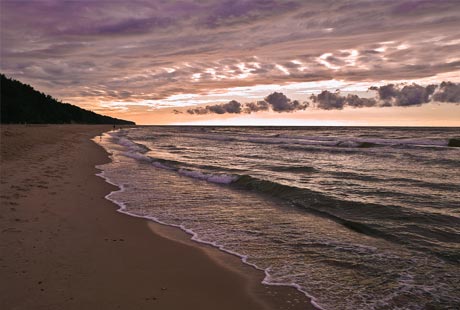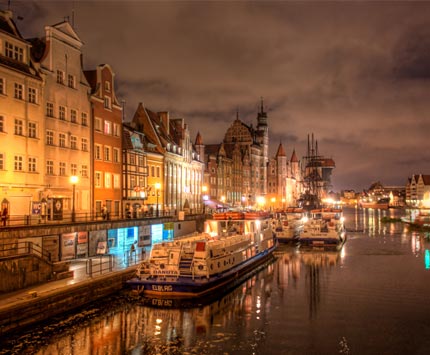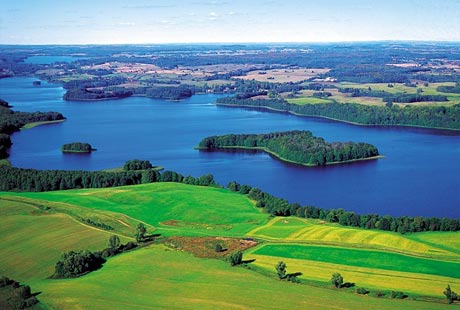Poland
Country statistics

Land area: 117,571 sq miles (304,509 sq km)
Total area: 120,728 sq miles (312,685 sq km)
Population (2011 est.): 38,415,284 (growth rate: -0.08%); birth rate: 9.96/1000; infant mortality rate: 6.42/1000; life expectancy: 76.25
Capital City: Warsaw
Monetary unit: Zloty
Languages: Polish (official) 97.8%, other and unspecified 2.2% (2002 census)
Ethnicity/race: Polish 96.7%, German 0.4%, Belorussian 0.1% Ukrainian 0.1%, other 2.7% (2002)
Religions: Roman Catholic 89.8% (about 75% practicing), Eastern Orthodox 1.3%, Protestant 0.3%, other 0.3%, unspecified 8.3% (2002)
Country introduction

Poland is a country in Central Europe, bordered by Germany to the west, the Czech Republic and Slovakia to the south, Ukraine, Belarus and Lithuania to the east, and the Baltic Sea and Kaliningrad Oblast, a Russian exclave, to the north.
The surface of the country is marked by a long unbroken plain that runs from the Baltic Sea in the north to the Carpathian Mountains in the south. The north of Poland is dominated by sand, which are fine, clean and more beautiful than that found in the Mediterranean. The wide Baltic beaches run beneath high cliffs and is marked by several spits, and behind them, the sand forms dunes. Some of these are shifting dunes, like those near Leba, which resemble a real desert.
Between the Baltic coast and the rest of the country is a belt of coastal lakes. The Drawskie, Kashubian, Suwalki and Mazurian lake districts, the last containing the largest Polish lakes, Śniardwy and Mamry, were formed by retreating ice sheets and draining floodwaters occurring as a result of ice calving ahead of the receding glacier.
Poland is bordered to the south by a belt of mountains. These include relatively new ranges like the Carpathians and the Tatras, but there are also ancient formations which go back to the beginnings of the Earth's history 4.6 billion years ago (see The Age of the Earth). These are the Sudeten mountains, which have been eroded, risen again, and even been subjected to the action of volcanoes. They include Europe's only Table Mountains, exceptional for the fact that they were built up not in folds, but in plates made of horizontal layers of sandstone.
There are a number of rivers and its tributaries that flow through the territory of Poland. The Narew, Europe's only braid-shaped river, spreads wide near Bialystok and splits into branches like the Amazon. Meanwhile the Biebrza near Goniadz turns the whole terrain into a succession of marshes which continue for many miles.
The culture

Poland has a rich history, dating back to more than a thousand years ago. It's culture has progressed at the crossroads of the Byzantine and Latinate worlds in a continuous interaction with a number of ethnic groups living in Poland.
The advent of people into Poland from different parts of the world with different cultures helped to spread the true Poland culture providing a completely new flavor to it. The fusion of the East and the West are best reflected in the nature of Polish culture. Their customs, manners, style, traditions and even their cuisine is an outcome of the balance of their own history and external influences.
The rich quality of Poland culture is well manifested in the beautiful architectures that the Polish towns exhibit. Polish architecture very distinctly display a whole spectrum of European styles. Although most of the examples have been destroyed in the course of history there are some castles, churches, and stately buildings that still uphold the glory of Poland culture. Some were painstakingly restored, like Wawel Castle, or completely reconstructed after being destroyed in World War II, including the Old Town and Royal Castle in Warsaw, as well as the Old Towns of Gdańsk and Wrocław.
Art is an integral part of Polish culture and has had a very positive influence on a global stage. Many famous artists like Jacek Malczewski, Stanisław Wyspiańsk, Józef Mehoffer, Stanislaw Witkiewicz and Józef Marian Chełmońsk are Polish citizens. Poland's museums exhibit impressive collections of art that include international masterpieces such as Leonardo da Vinci's Lady with the Ermine, at the Czartoryski Museum in Krakow, as well as Hans Memling's The Last Judgement, in the National Museum in Gdansk. Other attractive collections and pieces are showcased in ethnographic and open-air museums.
It was as far back as the 14th century that Polish Literature was first written and reflects the refined nature of Poland culture. Jan Kochanowski of Poland had been recognized as a leading representative of the Renaissance Literature in Europe.
Music is central to Poland Culture and is inspired by the Polish Folklores. The fineness of Polish Classical music is appreciated by music lovers from all around the world. Poland also boasts such well-known music festivals as Wratislawia Cantans and the International Festival of Contemporary Music, Warsaw Autumn.
Attractions & landmarks

Poland has a diversified natural environment, which is relatively unaffected by human development. Visitors are attracted by the mountains, the beautiful sea beaches, forests, lakes and rivers. Among the most popular destinations are the Tatra Mountains. While there it is recommended to take a walk in the splendid Koscieliska Valley, Chocholowska Valley, or the Rybi Potok Valley. The Polish Tatra Mountains are divided into two parts, the High Tatra Mountains and the Western Tatra Mountains. The High Tatra Mountains are much higher than the Western Tatras, and they are more spectacular. The highest waterfall in Poland, Wielka Siklawa, which is 70 m (229 ft) high, is located in the High Tatra Mountains. The Western Tatras are less challenging for those who are adventurous, but they are very suitable for those who want to enjoy a relaxing vacation in the middle of the nature.
Beautiful resorts and towns can be found on the 500 km (310 miles) long Polish seaside, where visitors can spend a relaxing vacation. Some of the most popular seaside resorts in Poland are Sopot, Gdynia, Hel, Kołobrzeg and Swinoujscie.
The northern part of Poland consists of five important lake districts, the most famous being the Masuria and Pomerania, the others are the Suwalki, Kashubia, and the Great Poland Lake District. Tourists can practice and indulge themselves in all kinds of water sports in these lakes and spend their time fishing and swimming. Beautiful little romantic villages around the lakes can also be visited, which preserve the Polish tradition of hospitability. Beside the lakes and the forests present, further north visitors will be able to see the sandy beaches of the Baltic Sea.
The Polish capital of Warsaw is filled with outstanding landmarks and monuments, many which have survived an interesting past of battles, wars and the uprising in 1944 (see World War II). Today, many of Warsaw's best landmarks remain very much as they appeared centuries ago, such as the Ratusz (City Hall) on the Plac Bankowy, and the Grand Theatre on the Plac Teatralny, both of which date back to the 1830s.
The tallest building in Warsaw and throughout Poland is the Palace of Culture and Science, which stands proudly on the Plac Defilad. Standing at just over 231 m (757 ft) in height and boasting 42 floors, with 3,288 different rooms, this famous landmark was constructed in the 1950s and gifted to the nation by the famous Russian leader, Josef Stalin.